

Creating Application using Spring Roo and Deploying on Google App Engine. Spring Roo is an Rapid Application Development tool which helps you in rapidly building spring based enterprise applications in the Java programming language.

Google App Engine is a Cloud Computing Technology which lets you run your application on Google's infrastructure. Using Spring Roo, you can develop applications which can be deployed on Google App Engine. In this tutorial, we will develop a simple application which can run on Google App Engine. Roo configures and manages your application using the Roo Shell. TheServerSide.com: Enterprise Java Community. A Collection of JVM Options. ScriptingListener - JBoss Community. The ScriptingListener Service The ScriptingListener service was introduced in JBoss v4.0.3.
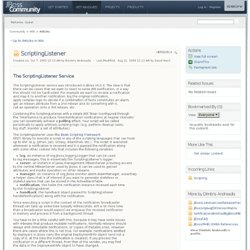
The idea is that there can be cases that we want to react to some JMX notification, in a way this should not be hardcoded. For example we want to receive a notification and map it to another notification, log the original notification, apply complex logic to decide if a combination of facts constitutes an alarm, Java HotSpot VM Options. Please note that this page only applies to JDK 7 and earlier releases.
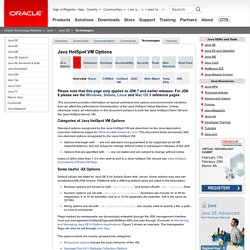
For JDK 8 please see the Windows, Solaris, Linux and Mac OS X reference pages. This document provides information on typical command-line options and environment variables that can affect the performance characteristics of the Java HotSpot Virtual Machine. Unless otherwise noted, all information in this document pertains to both the Java HotSpot Client VM and the Java HotSpot Server VM. Java EE at a Glance. Hibernate Querying 101 : tips and tricks. This article presents a few real-life tips and tricks for Hibernate querying.
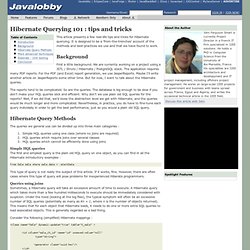
It is designed to be a 'from-the-trenches' account of the methods and best-practices we use and that we have found to work. Background First a little background. Java Servlet: Wiki. Life of a JSP file.

Introduction[edit] Servlets are most often used to:[citation needed] Process or store data that was submitted from an HTML formProvide dynamic content such as the results of a database queryManage state information that does not exist in the stateless HTTP protocol, such as filling the articles into the shopping cart of the appropriate customer To deploy and run a servlet, a web container must be used. A web container (also known as a servlet container) is essentially the component of a web server that interacts with the servlets.
Web Services for Remote Portlets WIKI. Overview[edit] The WSRP specification defines a web service interface for interacting with presentation-oriented web services.
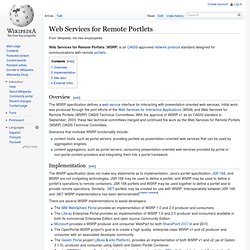
Initial work was produced through the joint efforts of the Web Services for Interactive Applications (WSIA) and Web Services for Remote Portlets (WSRP) OASIS Technical Committees. With the approval of WSRP v1 as an OASIS standard in September, 2003, these two technical committees merged and continued the work as the Web Services for Remote Portlets (WSRP) OASIS Technical Committee. Scenarios that motivate WSRP functionality include: content hosts, such as portal servers, providing portlets as presentation-oriented web services that can be used by aggregation engines;content aggregators, such as portal servers, consuming presentation-oriented web services provided by portal or non-portal content providers and integrating them into a portal framework. Implementation[edit] The WSRP specification does not make any statements as to implementation.
Enterprise Java Community: Introduction to the Spring Framework. Check out these updated Tutorials for Spring 3 and Hibernate 3.x Since the first version of this article was published in October, 2003, the Spring Framework has steadily grown in popularity.

It has progressed through version 1.0 final to the present 1.2, and has been adopted in a wide range of industries and projects. In this article, I'll try to explain what Spring sets out to achieve, and how I believe it can help you to develop J2EE applications. Yet another framework? You may be thinking "not another framework. " I believe that Spring is unique, for several reasons: It addresses important areas that many other popular frameworks don't. Spring is not necessarily one more framework dependency for your project. An open source project since February 2003, Spring has a long heritage. Since January 2003, Spring has been hosted on SourceForge.
Struts Wiki. JavaServer Pages: Wiki. Overview[edit] The JSP Model 2 architecture.
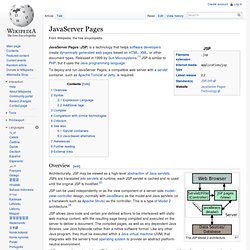
JSP can be used independently or as the view component of a server-side model–view–controller design, normally with JavaBeans as the model and Java servlets (or a framework such as Apache Struts) as the controller. This is a type of Model 2 architecture.[3] JSP allows Java code and certain pre-defined actions to be interleaved with static web markup content, with the resulting page being compiled and executed on the server to deliver a document. The compiled pages, as well as any dependent Java libraries, use Java bytecode rather than a native software format. JSPs are usually used to deliver HTML and XML documents, but through the use of OutputStream, they can deliver other types of data as well.[4] The Web container creates JSP implicit objects like pageContext, servletContext, session, request & response.
Syntax[edit] JSP pages use several delimiters for scripting functions. MyEclipse Hibernate Introduction Tutorial. In the early years of Java database and web programming, developers accessed their databases using the different classes provided by the java.sql package; you may even remember doing this yourself.
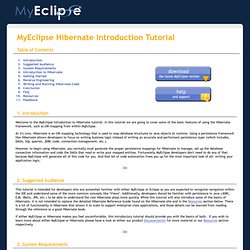
Such usage consisted basically of getting a Driver from the DriverManager, creating a Connection, using the Connection, handling exceptions properly, closing the connection and so on. A common problem at this stage was forgetting to clean up database connections and getting connection exceptions in your applications after they had been running for a while. A few years later "connection pools" became a big topic since they allowed the developer to stop worrying about creating and managing (cleaning up) DB connections and instead focusing on their SQL and ResultSet parsing code. Suddenly, we had mostly solved the problem of connection exceptions to the database in long-running applications.
At the time Hibernate came on the scene, the other persistence technology out there was EJB 2.x.